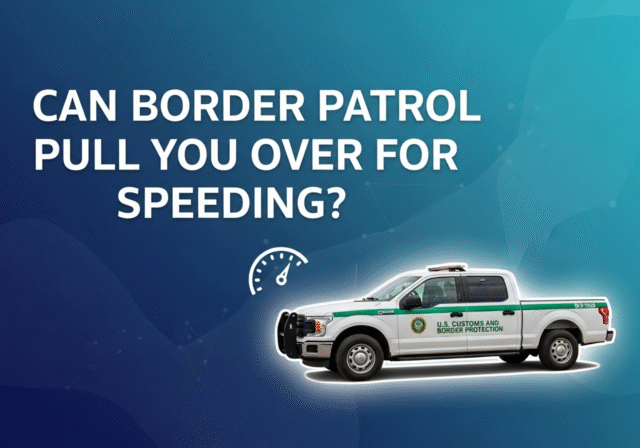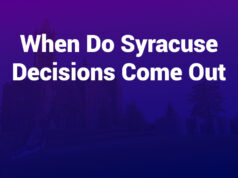Driving near the U.S.-Mexico border comes with unique law enforcement encounters. One of the most common questions drivers ask is: can Border Patrol agents pull you over for speeding? The answer is not as straightforward as a yes or no. The law grants Customs and Border Protection (CBP) certain powers, but those powers have limits.
In this article, you will learn what Border Patrol agents can and cannot do when it comes to traffic stops, what rights you have as a driver, and how federal authority differs from local police enforcement. You will also see recent examples, court rulings, and updated guidance that clarify the issue.
Border Patrol Authority Explained
Border Patrol operates under the Department of Homeland Security. Its primary mission is immigration and customs enforcement, not traffic safety. Unlike local police or state troopers, Border Patrol does not exist to patrol highways for speeding.
Federal law (8 U.S.C. § 1357) allows agents to:
- Question people about their immigration status.
- Patrol within a “reasonable distance” (up to 100 miles) from any U.S. border.
- Stop vehicles if they have reasonable suspicion of immigration violations.
This means their authority is tied to immigration enforcement, not general traffic laws.
Can They Pull You Over for Speeding Alone?
No. Border Patrol cannot stop a driver solely for speeding. Speeding is a violation of state law, and enforcement belongs to state or local police.
However, there are gray areas:
- If speeding creates suspicion of human smuggling, agents may use it as part of a broader stop.
- If agents witness reckless behavior near checkpoints, they may coordinate with local law enforcement.
- Agents can stop vehicles if they observe signs of immigration or smuggling violations, even if the initial trigger was speed.
So, while speeding alone is not their jurisdiction, combined circumstances may lead to a stop.
How Stops Work in the Border Zone
The “border zone” stretches 100 miles inland from any international boundary. This includes large cities like San Diego, Tucson, El Paso, and even some northern areas like Detroit or Buffalo.
Within this zone:
- Border Patrol can set up interior checkpoints.
- They can conduct roving patrols on highways.
- They need reasonable suspicion to pull over a vehicle.
Reasonable suspicion may include:
- Unusual driving behavior.
- Attempts to evade checkpoints.
- Vehicle heavily loaded or appearing modified.
- Information tied to ongoing smuggling investigations.
But speeding on its own does not meet the reasonable suspicion standard for immigration enforcement.
What Courts Have Said
Federal courts have repeatedly ruled on Border Patrol stops:
- U.S. v. Brignoni-Ponce (1975): Agents must have reasonable suspicion that a vehicle carries undocumented immigrants. Race or appearance alone is not enough.
- U.S. v. Arvizu (2002): Agents can consider the “totality of circumstances” to form suspicion.
- Recent cases: Courts continue to limit Border Patrol from acting like general traffic police.
These rulings emphasize that speeding is a state law matter unless tied directly to immigration enforcement.
What to Do If You’re Pulled Over
If a Border Patrol agent signals you to stop:
- Pull over safely.
- Stay calm and respectful.
- Ask the reason for the stop.
- Provide identification if requested.
- Remember your rights—agents cannot search your car without probable cause or consent.
If the stop appears to be only about speeding, note the details. That may later be challenged as an unlawful stop.
Role of Local Police
Local and state police handle speeding tickets. They have radar, traffic units, and authority under state laws. Border Patrol agents may contact them if a driver is speeding and suspected of other violations. In such cases, local police issue the speeding ticket, not Border Patrol.
This separation is crucial: Border Patrol is not traffic enforcement, and courts guard against “mission creep” into local policing.
Recent Developments
- Increased scrutiny: Civil rights groups like the ACLU monitor Border Patrol stops, especially those tied to speeding claims.
- Public complaints: Reports show some agents overstep, pulling over drivers without clear immigration-related suspicion.
- Agency reminders: CBP’s official guidance states agents cannot enforce general state traffic laws unless safety or immigration concerns overlap.
As of 2024, no new law has expanded Border Patrol’s power to ticket drivers for speeding.
Key Takeaways
- Border Patrol’s mission is immigration enforcement, not traffic policing.
- They cannot stop drivers for speeding alone.
- Reasonable suspicion of immigration violations must exist.
- Speeding can only be a factor if tied to smuggling suspicion.
- Local police, not Border Patrol, issue speeding tickets.
Common Misunderstandings About Border Patrol Stops
Many drivers assume Border Patrol agents have the same powers as state troopers. This belief creates confusion. Agents wear uniforms, drive marked vehicles, and carry weapons. To a driver, they appear just like traffic police.
But authority matters. State troopers enforce state laws. Sheriffs uphold county rules. Border Patrol has federal powers tied to immigration. Confusing these roles fuels unnecessary compliance with unlawful stops.
How Agents Justify Stops
When an agent pulls a driver over, the stated reason often includes phrases like:
· “Suspicious driving behavior.”
· “Possible involvement in smuggling.”
· “Vehicle avoiding checkpoint.”
If speeding occurs near a checkpoint or along a known smuggling route, it may be cited as a factor. However, the key is that speeding becomes one piece of a larger suspicion. Agents rarely admit to stopping someone for speed alone, since they know it exceeds their authority.
Geographic Impact
The 100-mile border zone includes huge areas. Roughly two-thirds of Americans live inside it. That means millions of drivers may encounter Border Patrol agents.
In Arizona, Interstate 19 runs from Tucson to Nogales. Agents patrol this route heavily. Drivers often get stopped near checkpoints, and many assume speeding was the cause. In reality, agents are looking for immigration violations, not traffic tickets.
In Texas, Highway 281 and I-35 near Laredo see similar stops. Again, speeding may draw attention, but tickets come from local law enforcement, not Border Patrol.
Data on Traffic Stops
Exact statistics are limited. CBP does not publish detailed breakdowns of how many stops involve speeding. Civil rights groups, however, have collected testimonies.
In one survey, drivers reported being pulled over for vague reasons like “driving too fast” or “acting nervous.” In most cases, no speeding ticket followed. Instead, agents questioned passengers about citizenship. This shows how “speeding” often acts as a pretext, not a primary violation.
Technology and Surveillance
Border Patrol uses advanced tools:
· License plate readers.
· Thermal cameras.
· Drones.
· Ground sensors.
These tools focus on detecting smuggling activity, not minor traffic infractions. Agents may, however, combine speed detection with surveillance data. For example, if a car is speeding away from the border after tripping a ground sensor, it becomes suspicious.
This integration of technology complicates the issue. While a radar gun alone may not justify a stop, pairing speed with other data creates a stronger case.
Checkpoints and Speeding
Interior checkpoints are legal within the border zone. At these points, every driver must stop. Speeding near or through checkpoints raises flags. Agents may stop and question a driver who seems to be evading or approaching recklessly.
But once again, the consequence is different. Local police handle the speeding ticket. Border Patrol addresses immigration or smuggling concerns.
Rights You Should Remember
When stopped by Border Patrol:
· You can remain silent about your citizenship status, though refusal may raise suspicion.
· You do not need to answer unrelated questions.
· You can refuse a vehicle search unless probable cause exists.
· You can request a lawyer if detained.
These rights apply whether the stop began with a claim of speeding or not.
Real-Life Examples
Example 1: Southern Arizona
A driver was pulled over on I-10. The agent claimed the vehicle was speeding. Instead of issuing a citation, the agent asked the driver and passengers for immigration papers. No speeding ticket followed. Civil rights groups later highlighted the stop as improper.
Example 2: South Texas
Near Falfurrias, a driver accelerated past 80 mph. Border Patrol agents pursued, citing erratic behavior. Local police were called. The driver received a speeding ticket from the sheriff, while Border Patrol checked for immigration violations.
Example 3: California Border Zone
A college student in San Diego reported being pulled over by agents who claimed she was “driving fast near the border.” The stop turned into questions about where she lived and her parents’ citizenship. No traffic ticket resulted.
These cases show a pattern: Border Patrol uses “speeding” as an entry point, but does not handle the traffic offense.
The Legal Grey Area
The courts continue to refine the boundaries. Some rulings stress that agents cannot act as highway patrol. Others allow leeway when smuggling suspicion exists. The balance is tricky—protect border security without eroding civil rights.
For drivers, the message is clear: speeding near the border may draw attention, but it should not result in a federal traffic ticket.
Policy Debate
Civil liberties advocates argue Border Patrol abuses its authority. They push for stricter limits on stops. They believe agents should not use traffic behavior as a cover for questioning immigration status.
On the other hand, supporters argue that smugglers often speed or drive recklessly. They say restricting Border Patrol makes it harder to combat human trafficking and drug smuggling.
Congress has not passed laws expanding Border Patrol’s power to enforce traffic laws. Instead, authority remains tethered to immigration enforcement.
Advice for Drivers
1. Know the difference between local police and Border Patrol.
2. Stay calm if pulled over.
3. Ask clearly, “Am I being stopped for an immigration matter, or a traffic violation?”
4. Cooperate within your legal obligations.
5. Record the interaction if safe to do so.
Documenting stops helps challenge improper behavior later.
Future Trends
Technology may reduce the need for direct stops. Automated license plate readers already scan millions of vehicles daily. Drones monitor border regions without engaging drivers.
Still, human judgment remains central. Agents on patrol must decide whether to initiate stops. That judgment sometimes includes citing speeding behavior, even if tickets are not issued.
Expect more lawsuits in coming years as drivers continue to challenge questionable stops. Courts will likely refine where immigration authority ends and state traffic authority begins.
Conclusion
The law draws a clear line: Border Patrol cannot pull you over just for speeding. Their authority exists for immigration-related enforcement, not traffic laws. Still, in the border zone, speeding combined with other factors may attract attention. Drivers should know their rights, respect lawful orders, and recognize the limits of federal versus state authority.














